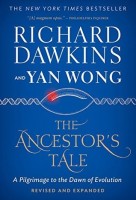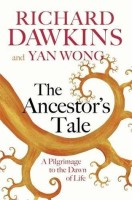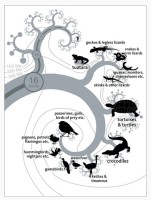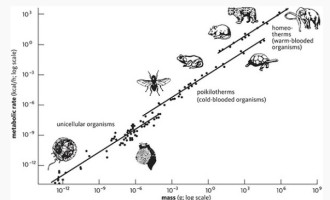 Title: The Ancestor’s Tale: A Pilgrimage to the Dawn of Life
Title: The Ancestor’s Tale: A Pilgrimage to the Dawn of Life
Author(s): Richard Dawkins, Yan Wong
Release year: 2016
Publisher: Houghton Mifflin (ENG),
Why in Database: An interesting case. More than ten years after the first edition of the book was published, author decided to re-edit it and re-publish it in an updated version (additionally, Yan Wong, who had an even greater contribution to it, was included as a co-author). The differences are varied, of the 13 turtle elements in the second edition, 2 are completely new, absent in the first edition, and five have been slightly rewritten. Which makes 7 changes, of 13 fragments, over 50%. That is why we decided to make separate note for each edition – here’s a note about first one.
Before each quote, we provide information whether in the previous edition a given fragment was the same, different or absent at all.
Fragment slightly edited between releases:
There are also cases where extensive regions of DNA show enigmatic resemblances between comparatively unrelated creatures. Nobody doubts that birds are more closely related to turtles, lizards, snakes and crocodiles than to mammals (see Rendezvous 16).
A fragment identical in both editions:
Most other vertebrates, such as fish and reptiles but not mammals, have three-cone (‘trichromatic’) or four-cone (‘tetrachromatic’) vision, and birds and turtles can be even more sophisticated.
A fragment identical in both editions:
Colour television and computer screens, doubtless because they are designed for our trichromatic eyes, also work on a three-colour system. On a normal computer monitor, each ‘pixel’ consists of three dots placed too close together for the eye to resolve. Each dot always glows with the same colour—if you look at the screen at sufficient magnification you always see only the same three colours, usually red, green and blue although other combinations can do the job.
Flesh tones, subtle shades—any hue that humans might wish to see—can be achieved by manipulating the intensities with which these three primary colours glow. But tetrachromatic turtles, for example, might be disappointed by the unrealistic (to them) pictures on our television and cinema screens.
New fragment, absent from the first edition:
Fossil and genetic evidence disagrees on the placement of turtles (Rendezvous 16)
A fragment identical in both editions:
A whale floats. Unlike a seal or a turtle, which still comes on land to breed, a whale never stops floating.
A fragment identical in both editions:
Even turtles that are otherwise wholly marine haul themselves up the beach to lay their eggs.
A fragment identical in both editions:
Before we get to the mammal-like reptiles, we face a somewhat tiresome point of terminology. Terms like reptile and mammal can refer to ‘clades’ or ‘grades’—the two are not exclusive. A clade is a set of animals consisting of an ancestor and all its descendants. The ‘birds’ constitute a good clade. ‘Reptile’, as traditionally understood, is not a good clade because it excludes birds. Biologists consequently refer to the reptiles as ‘paraphyletic’. Some reptiles (e.g. crocodiles) are closer cousins of some non-reptiles (birds) than they are of other reptiles (turtles). To the extent that reptiles all have something in common, they are members of a grade, not a clade. A grade is a set of animals that have reached a similar stage in a recognisably progressive evolutionary trend.
Fragment slightly edited between releases:
At Rendezvous 16, approximately 5,500 mammal pilgrims greet 20,000 sauropsids: snakes, lizards, turtles, crocodiles and, above them all, birds. They are the main group of land vertebrate pilgrims. The only reason I am regarding them as joining us, rather than we joining them, is that we arbitrarily chose to see the journey through human eyes.
Fragment slightly edited between releases:
Seen through sauropsid eyes, these pilgrims belong to two near equal-sized bands: the lizard-like reptiles or lepidosaurs, and the dinosaur-like reptiles or archosaurs.
New fragment, absent from the first edition:
Today, this branch is dominated by the 10,000 species of birds, although it also includes the crocodiles and (controversially) the turtles.
Fragment slightly edited between releases: dodano żółwi kawałek. (Podpis pod pierwszą z przytoczonych niżej grafik)
Reptiles (including birds) join. A breakthrough in the evolution of terrestrial vertebrates was the amnion, a waterproof yet breathable egg membrane. Two early-diverging lineages of these ‘amniotes’ survive today: the synapsids (represented by the mammals), and the sauropsids (20,000 living species of ‘reptiles’ and birds) who join us here. The phylogeny shown here is reasonably secure, save for the position of the turtles (no longer the deepest branch on the sauropsid tree, as was previously thought) and the earliest branching lizards.
Fragment slightly edited between releases:
These, then, are the sauropsid pilgrims, the lizards and snakes, turtles, crocodiles and birds, together with the huge concourse of shadow pilgrims—the pterosaurs in the air, the ichthyosaurs, plesiosaurs and mosasaurs in water, and most famously of all the dinosaurs on land.
A fragment identical in both editions:
McGavin’s next candidate for an evolutionary one-off is a beauty. It is the diving bell spider, Argyroneta aquatica. This spider lives and hunts entirely underwater but, like dolphins, dugongs, turtles, freshwater snails and other land animals that have returned to water, it needs to breathe air.



Author: XYuriTT
